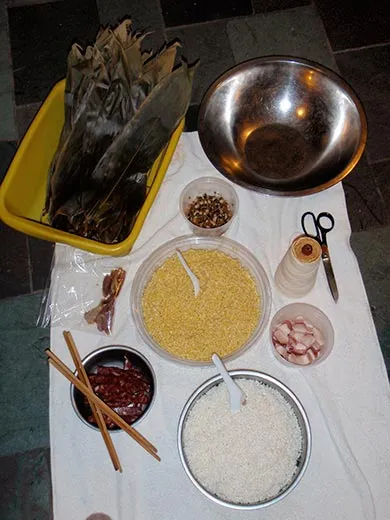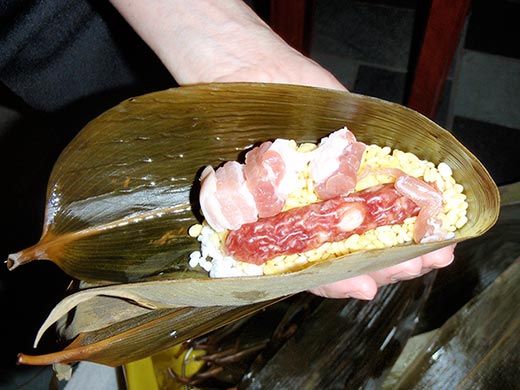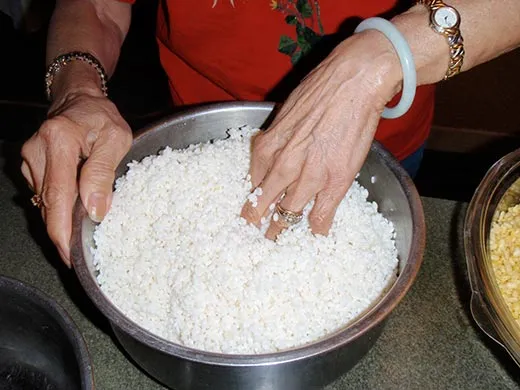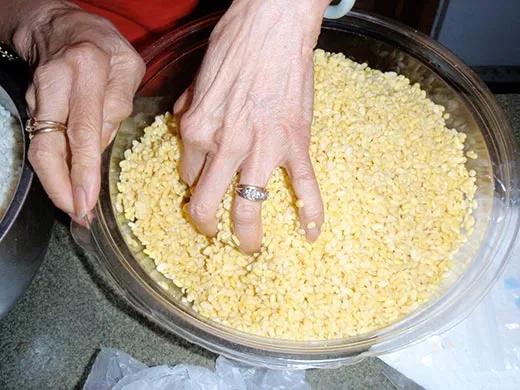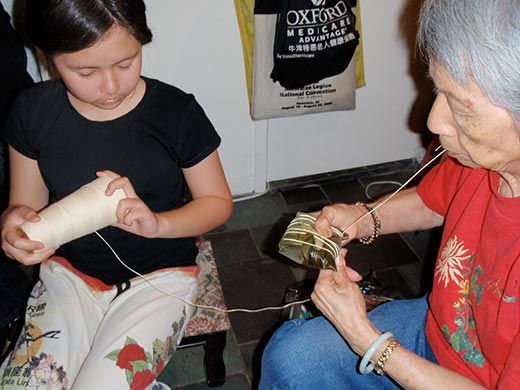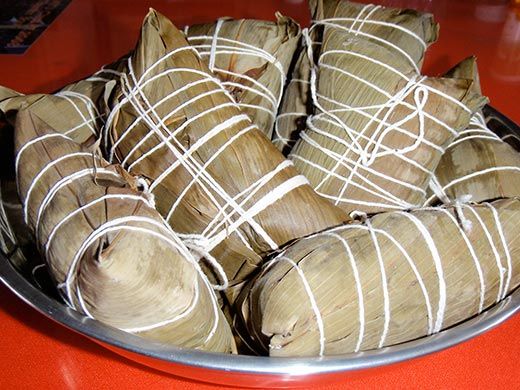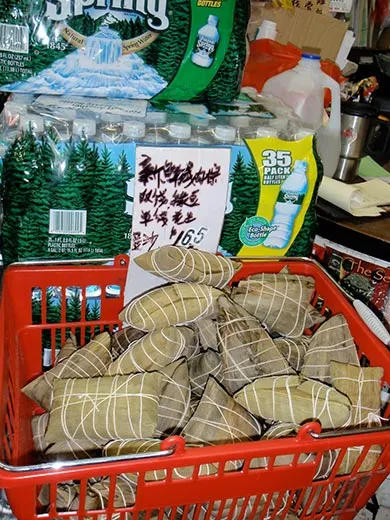Jung and Zongzi Recipe
Learn how to cook this traditional Chinese delicacy in a family recipe passed down from older generations
/https://tf-cmsv2-smithsonianmag-media.s3.amazonaws.com/filer/jung-served-on-leaf-631.jpg)
The Cantonese, from southern China, use a different name for the Mandarin dish zongzi; they call it jung. Since both my mother’s family and chef Martin Yan are from Guangdong, I am going to use jung for the purposes of this recipe, as well.
First, a primer on the main ingredients. “What’s not to like?” says Flavor and Fortune editor Jacqueline M. Newman. “It’s carbohydrates and protein.”
Rice, obviously, is the staple Chinese food, but pork is a close contender. That’s because it’s always been the most readily available, useless animal. “The cow was the farmer’s helping hand, so they didn’t want to waste it on eating his meat,” says Yan. “When you refer to meat, it means pork. If you want something else, you have to specify chicken meat, beef meat.” As for the mung, the shelled beans that resemble lentils, Yan says, “they’re to give textural contrast, and also to absorb some of the grease from the pork fat.”
Yan has an almost Proustian recollection of jung, which he stresses there is no one right way to make: “As far back as I can remember, around this time of year my mom would make some jung. The neighbors would make some jung. We all shared. Everyone might put something different inside, even if we were from the same neighborhood. It’s a tradition to exchange gifts of food. The same way that at New Year’s we bring oranges or tangerines to friends because they’re the color of gold, so we share jung at Dragon Boat time.”
My grandmother and her sister have been making and sharing jung every year for some four seven decades. For this year’s Dragon Boat Festival, I finally got my hands dirty and learned how to make it—though, in truth, my great-aunt did all the hard prep work. They differ on allowable extras—my grandmother likes to include black Chinese mushrooms, her sister thinks they dry out—but they agree on what basic ingredients constitute classic jung. According to my grandmother, you’re making jung right if it looks like a Chinese woman’s bound foot from a century ago. If you can get past that image, please enjoy this recipe:
THE CHU SISTERS’ JUNG RECIPE
INGREDIENTS
2 ½ lbs of glutinous rice
1 lb mung (shelled green beans)
5 lap cheung (Chinese sausage) links
1 lb pork belly
1 package of dried bamboo leaves
Makes about 20.
DIRECTIONS
The night before:
Cut the pork belly into half-inch-thick slices. Salt it.
Soak the rice and mung – separately – for a couple of hours – in water. After you drain the water, put half a teaspoon of salt in each and mix.
To prepare the bamboo leaves: Boil enough water to cover all the leaves. Add one tbsp baking soda. Turn off the heat. Add bamboo leaves. Soak for an hour. Rinse with clear water and soak in clear water overnight.
The next day:
Wash each leaf with a vegetable brush, length-wise on both sides. You’ll need three to four leaves per jung. Make a few extra in case of breakage or mistakes.
Cut the lap cheung in half lengthwise then half again width wise.
Take one bamboo leaf. Fold it in half width-wise so that the smooth part faces in. Then, lengthwise, fold about a quarter of the leaf up, to the seam, so that it creates a cone. Take another leaf and fold it around the first, with the bottom edge of the second touching the top leaf’s middle seam.
If you have Chinese soup spoons, use them to measure the ingredients. (Otherwise use a tablespoon.) Put a heaping spoonful of rice in the leaf, packing from the fold out. Add a heaping spoonful of mung beans. Add one piece of pork belly in the middle, one piece of lap cheung on top. Cover with another heaping spoonful of mung then another heaping spoonful of rice on top.
Take a third leaf; wrap it around the second, with the bottom edge of the leaf running along the seam of the second. Pat down the ingredients and hold the cone firm while folding the third leaf lengthwise and closing it on the same side that the first leaf’s edges are folded up. Grasp the jung from the bottom, keeping both edges closed. Fold the top edge of the leaves down on the same side as the other closures. Smooth the leaves out. Hold it firmly, but don’t squeeze it too hard; it will break the leaves and make everything fall out.
Hold the end of the string with your teeth. Wind the other end around the jung width-wise maybe 10 times, so that you have sealed the whole length of the jung. Criss-cross the ends of the string as if you’re tying a package. Then wind the string twice around the jung length-wise. Make a double-knot.
To Cook:
Put all the jung in a huge pot of water so that even the ones on top are covered with water. Bring to a boil. Turn to medium-low heat to keep a slow boil. Cover the pot and cook for 2 ½ hours, checking occasionally to make sure the jung are still submerged in water. Halfway through, carefully stir up the jung so that the ones on top swap places with the ones on the bottom. When done, you can eat immediately—for breakfast or lunch! They’re microwave reheatable.
VARIATIONS
Vegetarian: Replace the meat with black-eye peas and dried black Chinese mushrooms. Soak the mushrooms for an hour, squeeze the water out by hand, and chop really finely. Mix with the black-eye peas, soy sauce and oil.
Eggs: Many people, my great-aunt included, add a cooked salted duck egg yolk, but a plain chicken egg yolk could work too. Chop in quarters, use two quarters for each jung.
Martin Yan’s Special: Add dehydrated minced meat, or chopped jerky, in lieu of sausage. Many people use boiled peanuts, but Yan prefers Macadamia or pecans. If you can find lotus leaves, Yan prefers these to bamboo because they’re larger.
Jacqueline M. Newman’s sweet style: Just glutinous rice, red bean paste and pre-boiled or dried chestnuts.
